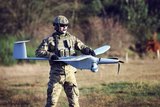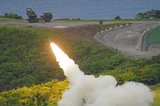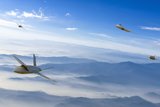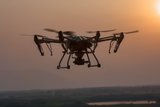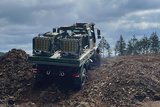Vertical Takeoff and Landing (VTOL) UASs: Transforming Modern Warfare with Agility and Adaptability
This article is brought to you by Aeronautics
In today's rapidly evolving defense landscape, speed and flexibility are vital. As battlefields grow increasingly complex, military forces need versatile tools to address these challenges. Recent conflicts have highlighted the renewed importance of land maneuvering, making advanced organic intelligence capabilities crucial due to the dramatic improvement in enemy air defense systems. The Orbiter 4 VTOL UAS exemplifies a synthesis of availability, agility, adaptability, intelligence capabilities, and endurance, setting a new standard in the tactical UAS landscape. This advanced technology redefines unmanned systems in high stakes environments, offering a distinct combination of maneuverability and prolonged operational capability.
Adaptability in the Field
The Orbiter 4 VTOL UAS stands out with its ability to take off and land in confined areas and rugged terrains where fixed-wing UASs falter. Its vertical takeoff and landing capabilities ensure accurate operations in unpredictable conditions, eliminating the need for extensive runways or infrastructure. Forces can deploy the Orbiter 4 VTOL kit to quickly adapt to changing terrain, launching from challenging environments with precision. This adaptability is tailored to mission requirements, with the VTOL kit easily assembled at the field level (O level).
Eyal Aasenhaym, VP Marketing & BD at Aeronautics, explained: "The Orbiter 4 VTOL allows the maneuvering force to operate even in an area with many obstacles, such as rocks, trees, and more, thus completing the mission and enabling high levels of availability."
Multi-Mission Success and Superior Endurance
The Orbiter 4 VTOL kit allows forces to choose the best launch method depending on the mission profile. For missions demanding pinpoint accuracy, the VTOL mode offers precise takeoff and landing. For extended surveillance and reconnaissance, operators can opt for the traditional launcher and parachute/airbag system, benefiting from an impressive 24-hour endurance. This versatility makes the Orbiter 4 VTOL UAS ideal for a range of missions, including Intelligence, Surveillance, Target Acquisition, and Reconnaissance (ISTAR), search and rescue, and logistics support. The ability to switch between VTOL and traditional launcher configurations, at the field level, ensures that forces are well-equipped to handle various mission demands.
An experienced operator of the Orbiter system emphasized the practical advantages of the Orbiter 4 VTOL in tactical operations: "The Orbiter 4 VTOL UAS takes another step in reducing our logistical footprint, both by increasing operational flexibility and enabling high levels of availability. First, we got rid of the hangars and runways; now we can even put aside the launcher and clear recovery grounds for specific missions, deploying and operating from the most confined and challenging terrains. All this while enabling the flexibility for the longer endurance missions using the launcher and VTOL kit removed."
Serviceability, Flexibility, and Multiple Payloads
As a tactical UAS, the Orbiter 4 provides flexibility with its multi-payload capabilities, supporting a wide array of sensors and equipment for simultaneous missions. Whether it's infrared cameras, SAR or COMINT, the Orbiter 4 enhances situational awareness and data collection in all conditions - day, night, severe weather conditions, enabling large area coverage. Its modular design and low logistical footprint also ensure rapid serviceability and deployment. Small teams can quickly assemble and launch the system in a rapid turnaround time without needing complex infrastructure. Furthermore, the system's high resilience to adverse weather conditions make it suitable for maritime and land-based missions' joint operations. The dual payload configuration, incorporating EO/IR in addition to SAR, SIGINT, and other payloads significantly enhances the ISR capabilities, by performing the Detection to Surveillance cycle with a single AV.
Ease of Use and Reduced Logistical Footprint
The Orbiter 4 VTOL UAS streamlines operations through intuitive design and reduced logistical demands. Operators benefit from its straightforward interface and automation features, which simplify mission management and require minimal training. Its portability and runway-free operation make it quickly deployable, reducing the logistical footprint and allowing forces to deploy, turnaround and reposition swiftly.
A New Era in Battlefield Technology
By blending the agility of VTOL with the comprehensive power of the Orbiter 4 UAS, Aeronautics has developed a system that fundamentally transforms how military operations are planned and executed. Whether used for reconnaissance, logistics support, or combat missions, the Orbiter 4 VTOL UAS offers a new standard in battlefield adaptability that will shape the future of modern warfare.
More from Industry Spotlights
-
![The future is here: Sixth-gen air dominance]()
The future is here: Sixth-gen air dominance
How RTX is equipping the military airspace – for today’s fleet and tomorrow’s fight.
-
![De-Risking the Future: Manufacturing Certainty for Unmanned Systems]()
De-Risking the Future: Manufacturing Certainty for Unmanned Systems
How strategic manufacturing partnership solves the industrialisation triad — Scale, Compliance and Cost — for hyper-growth defence tech innovators.
-
![Battlefield mobility, made in the UK]()
Battlefield mobility, made in the UK
How does Britain ensure that we can preserve the lives of our soldiers and allies – now and in the future – with homegrown innovation and resilient domestic manufacturing? At Pearson Engineering, we are proud to be a central part of the answer to this increasingly important question.
-
![Strengthening Baltic defence capabilities]()
Strengthening Baltic defence capabilities
How Latvia is bolstering its territorial defences, industrial capacity and international cooperation with Dynamit Nobel Defence’s SKORPION2 Remote Mining System.
-
![Barco’s vision to trust: from past to future]()
Barco’s vision to trust: from past to future
Barco’s story is one of constant evolution enabling more immersive, reliable, and future-ready training experiences.
-
![How are next-generation ejection seats helping pilots when they need it most?]()
How are next-generation ejection seats helping pilots when they need it most?
The ACES 5 ejection seat from RTX’s Collins Aerospace introduces new, innovative and patented technologies to help save lives.







